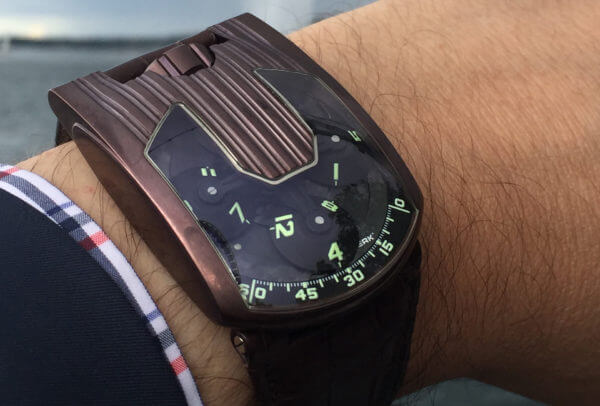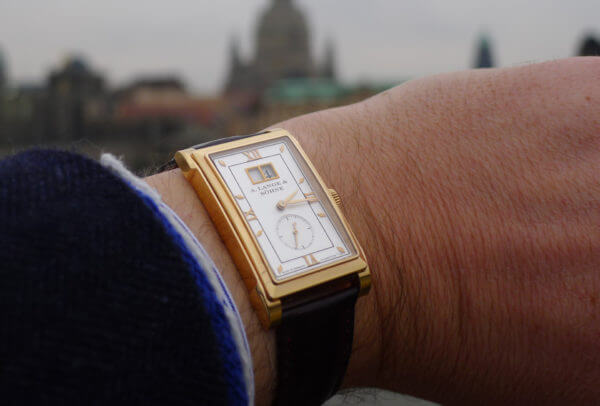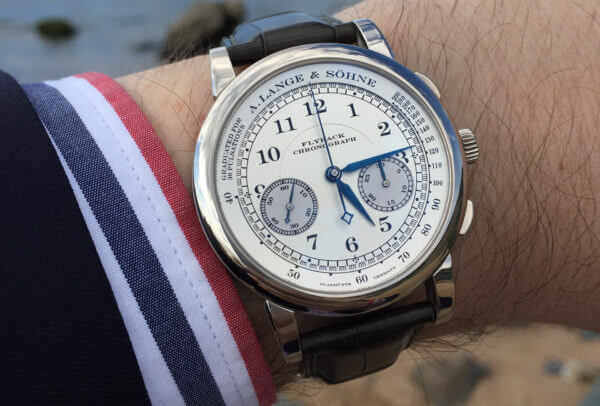It’s in my blood. My grandfather had a collection of pocket watches, American like him, which included a quarter repeater. I’d say I developed a serious interest around twenty years ago when my work brought me to Paris. That’s when I bought my first mechanical watches and became aware of how much was on offer in the city’s specialist stores. Then, around the late 1990s, I discovered watch forums, which back then meant Chronomania, Purists, Timezone and later Forumamontres in France and Relojes Especiales in Spain. I learned a huge amount from them. Of course, watchmaking is an endless subject and I still read up about watches every day in print and online. I started my blog in 2008, at the same time I became a moderator at Purists. I wanted to write in French; it helps me be culturally in synch with my readers and also because I enjoy writing in the language of watchmaking!
The idea came to me gradually, as I observed the widening gap between what brands were offering and what customers, such as myself, want. Many of my acquaintances are collectors, people who are serious about watches. Talking to them, I realised that more and more had stopped buying new watches, or were drastically scaling back their collections. I wanted to understand why. The watch sector, the people and the companies in it, mean a lot to me and I don’t want to see it plunged into long-term crisis. Putting my thoughts into words gives me a better grasp of the problem and, in my own small way, lets me pass on the warning signals.
I think people are less inclined to purchase blindly. I truly believe the current situation reflects a problem with supply, not demand. There are as many people who love watches as ever, yet a substantial number have stopped dropping into stores and have no plans to purchase a new watch. The question we need to answer is, why? There has been a marked increase in prices over several years and this is clearly one explanation, but there are other factors too. I honestly believe the matrix analysis is too reductive, and that brands need to listen more to staff on the retail floor, the ones who are in contact with the end customer.
This is how I see it: there are three customer segments – collectors, enthusiasts, and the ordinary customer who doesn’t buy “a” watch but “the” watch as a gift to themselves or to celebrate a special event. The first two segments are important as opinion leaders, but the most strategic segment is obviously the third one, as these are the customers who account for the overwhelming majority of volume sales… and they are clearly a far more mature segment than in the past. They pick up information from the various online media and aren’t afraid to ask all kinds of questions. Their understanding of watchmaking has moved up a notch, meaning they no longer buy with their eyes closed. Particularly at those prices! Before, you could expect to spend one month’s salary on a good watch. Now two months’ salary isn’t enough. In these conditions, the ordinary customer thinks twice before handing over their cash.
As a customer of a prestigious clothing brand, after its takeover by a major group I remember being invited to sit down for a full hour and a half with a sales associate who wanted to find out precisely what I was looking for from the brand. Several customers were consulted per store, worldwide. I really appreciated being able to take this time. In the twenty years I’ve been buying watches, no brand has ever approached me or any of my friends for a similar survey. Of course there are the constant informal exchanges with brands at fairs or other events, but they never take place within a structured framework. It’s a pity, because feedback from a survey of customers in the three segments would be far more informative than some of the broad-based documents I’ve seen here and there. It’s a global market, and of course customers don’t all have the same expectations or behaviour but similarities can be observed, such as this more in-depth knowledge and certain key products’ undeniable appeal. Except that however well they sell, these icons don’t constitute a market! The other products have to sell, too. You have to know your customer if you’re to convince them to buy.
The watch sector has come to a crossroads, which is why this is such an exciting period. The core issue in the medium term is to recruit a new customer base, and in this respect I understand why established brands are adapting their communication strategy to these new customers. But before starting on communication, they need to be looking at the products. What are we offering and at what price points? My concern is that changes to communication aren’t enough to attract new customers in search of exclusive, creative, personalised products at fair prices. And before they can even start winning them over with these products, there’s the small matter of convincing them to wear a watch at all!
It’s seems to me we’re putting the cart before the horse. Whenever I chat with young watch buyers, their motivations are light years away from the messages the traditional brands are broadcasting. One young woman told me she’d started wearing a watch again because it wasn’t so distracting. Previously she’s used her phone to check the time, and was constantly getting sidetracked by messages. The mechanical watch gives us freedom. It’s environmentally-friendly because there is no planned obsolescence and it doesn’t run on batteries. These are all themes that appeal to these generations and which aren’t part of brands’ communication.
Before jumping into bed with influencers, most of whose followers will never buy a watch above €500, brands need to start at the beginning with the product. Otherwise, the market for new watches will gradually split into two extremes, with Haute Horlogerie, collectors’ niche brands at one end and the small, creative, fun brands at the other – the ones that will meet millennials’ needs with watches priced at a few hundred euros. It’s a complex situation. Brands must be capable of talking to and in some instances winning back their traditional customers while making their first inroads in conquering a new clientele. It’s an enormous task because it involves changes in every aspect of the profession: products, communication and distribution. But difficult contexts create the most opportunities. It’s when the cream rises to the top. Recently, I’ve spotted some interesting trends at certain brands: prices are more coherent, products have greater substance, and communication is more sincere. Let’s hope SIHH 2018 confirms this.
No. Like it or not, Instagram can’t be ignored. What’s important is to distinguish between accounts such as mine, which are for sharing photos, and those of brands and certain other stakeholders which are clearly business-oriented. Whereas I find this new algorithm rather frustrating, others who have different objectives will appreciate its power. Having said that, brands need to give their Instagram presence serious thought. Which products do we feature, what do we want to say, how do we adapt content – you don’t communicate on Instagram as you do on Facebook -, what’s the most effective way of directing potential customers towards physical or online stores, etc. Ultimately, this presence must be built into an authentic digital strategy.
This still leaves us with the age-old question of how credible are statistics? Given how easy it is to buy and interact with “real” followers, can we properly measure the impact of what we post on our own account or through an influencer? Tools exist, but differentiating between genuine contacts and impostors remains a complex process. This further complicates matters for brands which are bombarded with requests from all and sundry. Lastly, the capacity to convert Instagram engagement into sales has yet to be proven. It’s not enough to have an Instagram account with thousands of followers. It all comes back to the maturity of customers who need more than a few nice photos to convince them to buy.
I’d like to look more into brands’ communication style and the themes they choose for their ad campaigns. I’m in no hurry though. What I most enjoy is writing about watches and with so much going on, plus Salon International de la Haute Horlogerie (SIHH) around the corner, there’s no shortage of new models to discover!
My latest acquisition of course, which would be the Urwerk 103.08. This, to me, is the perfect example of what creative contemporary watchmaking ought to be. It’s a complete rethink of the old principle of the wandering hours display. It’s a bold, daring watch yet it radiates a certain elegance and is comfortable on the wrist. I like it a lot. It makes me think that setting up the Carré des Horlogers at SIHH was an excellent idea.

Unfortunately I wasn’t able to attend the last SIHH, but I’ll make up for it at the next one. As always, I’ll be wearing a watch from my favourite brand, Lange & Söhne. Probably a Cabaret. I really like this rectangular watch. It’s elegant and just right for SIHH.

Any watch fan would tell you it’s impossible to answer that question! But I’ll give it a go. Out of my collection, I would say the first edition of Lange & Söhne’s 1815 chronograph. A chronograph movement from Lange & Söhne is something quite exceptional, both to observe and to use.













